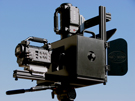LLE then publicized an industry effort to shift the regulatory basis for lasers in cinemas. Sony has announced participation with that effort, though they haven’t made any further announcements since their 2008 technology release (or the recent rumor that they are working with a French group on a cinema-based laser project.) And now NATO, the US-centric national association of theater owners, is forming a laser task force
Here are a few paragraphs of the Optics.com article. Er note that the anti-green speckle effort that is mentioned in the article takes on significance when reports come back from Rochester indicating that they haven’t completely handled the problem yet.
Optics.org – Laser projectors promise brighter 3D experience – Excerpts:
“Xenon lamps have reached their practical limit for high-brightness applications,” said Bill Beck, a co-founder of LLE. “High-lumen projection tops out at about 30,000 lumens with an 8 kW power supply. Most of the size, weight and power consumption of these projectors is driven by the illumination system and supporting optics, which is why they are very big.”
Laser alternative
LLE’s alternative is a light engine producing red, green and blue primaries from the same laser source, with the output coupled to a digital projector using optical fiber. With virtually all the laser power successfully reaching the projector chips, the result is a system that can deliver two- to five-times the brightness level of a xenon lamp.
“Our design is a diode-pumped, solid-state laser system using very mature, low-cost GaAs pump diode bars, MOPA architecture, and non-linear optics for wavelength conversion,” commented Beck. “It satisfies all the key requirements: power for 3D brightness, a long lifetime, and high wall-plug efficiency for decreased operating costs. The beam also has a low etendue, which is beneficial for fiber delivery and for scaling the power to higher levels.”
The company says that it can scale up the power of its system by aggregating the output from several light engines. “Our strategy is to provide RGB engines in increments of 30,000 white balanced lumens,” said Beck. “These will initially be aggregated, so as to supply projectors with input powers of up to 60-90,000 lm. In terms of watts, these modules would output 75-90 watts of RGB.” The company envisages these multiple RGB engines being delivered to a digital projector by optical fiber, potentially 50 feet away, allowing “a very small box to become a very bright box.”
Speckle secret
LLE also says it has cracked one of the field’s particular headaches: green speckle. When a highly coherent light source is used for projection displays, viewers can sometimes perceive an interference pattern as an image artifact, although the severity of this problem can be very subjective. It just so happens that the green channel is the hardest to acceptably ‘de-speckle’, because of the eye’s high sensitivity to those wavelengths.
Beck is keeping the secret of LLE’s victory over green speckle to himself, but admits that it was not an easy fight. “Dealing with speckle was one of the key challenges, up there alongside the development of a low-cost middle-volume manufacturing platform. We have worked for three years to eliminate the speckle, and have existing and pending IP in this area. All I can tell you is that it is really, really hard and lots of people have tried.”
The LLE light engine is also green in spirit, contributing to the energy savings that the cinema industry expects to make as digital projection systems become more widely adopted. LLE predicts that RGB laser illumination will reduce operating costs for movie theater owners by potentially $10,000 per screen per year, by eliminating the need to replace expensive xenon arc lamp projector bulbs and reducing electricity use by as much as 50 per cent. As Beck noted: “Our business model is very much in line with the trend to replace low-efficiency lamps with solid-state solutions, offsetting higher up-front price with lower total cost of ownership.”
Other Articles in this series:
Laser Light Engines gets IMAX funding– Putting Light on the Subject

 Element Technica Quasar™ 3D Rigs Now in Use
Element Technica Quasar™ 3D Rigs Now in Use 3D Film Factory Introduces First Affordable 3D Rig For Red One Cameras
3D Film Factory Introduces First Affordable 3D Rig For Red One Cameras